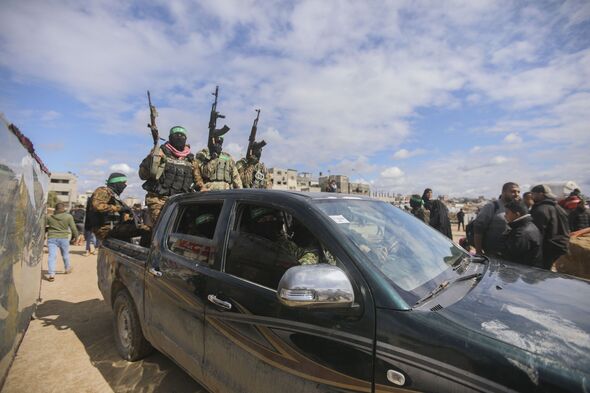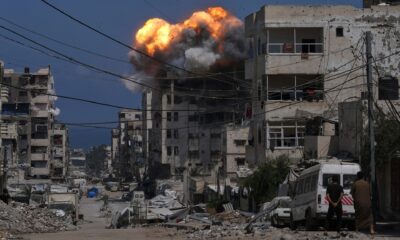World
Rebel Clan Establishes Hamas-Free Zone in Khan Younis

Violence erupted in Khan Younis last week as fierce clashes unfolded between local clans and Hamas forces, resulting in numerous casualties. Reports indicate that dozens lost their lives amid the conflict, which saw Hamas fighters allegedly paraded through the streets. Notably, no Israeli soldiers were present during these confrontations, which The Telegraph covered extensively. This violence offers a glimpse into the shifting dynamics within Gaza as the world anticipates a potential hostage release scheduled for October 23, 2023.
In the midst of this turmoil, Hossam al-Astal emerged as a prominent figure opposing Hamas. He leads a militia known as the “Strike Force Against Terror,” which has established a small enclave in Khan Younis, asserting it as a “liberated area from Hamas occupation.” This territory spans approximately one square mile and, according to al-Astal, has provided refuge for around 200 individuals seeking safety from Hamas control.
Al-Astal’s militia has reportedly received tacit support from Israel, allowing for operational freedom and protection from airstrikes. He claims that his forces recently thwarted an attack in the Muwasi region with the assistance of the Israel Defense Forces (IDF). While Israeli military officials did not acknowledge the militia group, al-Astal’s assertion reflects a complex relationship forming between local armed factions and the Israeli military.
Calls for Support from International Figures
Amid these developments, al-Astal expressed openness to international assistance, notably mentioning Tony Blair as a potential leader for Gaza’s future governance. He described Blair as a “decent politician” and expressed enthusiasm for cooperation that would benefit the people of Gaza. Al-Astal’s militia represents a potential shift in local governance should Hamas be disarmed and a transitional authority established.
As a ceasefire holds, anticipation grows regarding the release of Israeli hostages. This development raises critical questions about the future of Gaza, particularly concerning Hamas disarmament and the broader governance structure that could replace it. The Trump administration has been vocal in pressuring both sides to formalize a settlement that includes a ceasefire and the safe release of hostages, yet many details regarding post-conflict governance remain unresolved.
The Risk of Civil Conflict
The situation in Gaza remains precarious as the IDF has largely retreated from urban areas. Reports indicate that Hamas’s internal security forces are resuming their patrols, raising concerns about escalating tensions between rival factions. Al-Astal warned that the region risks sliding into a civil war, particularly if the power vacuum left by the IDF is filled by Hamas once again.
He emphasized, “We will not stop fighting Hamas. We have martyrs – Hamas has our blood on their hands.” Al-Astal commands a network of former security personnel from the Palestinian Authority (PA) who are prepared to act against Hamas if necessary. He underlined the importance of local leadership in any future governance, stating that those who truly understand the needs of Gazans should be in control.
Al-Astal criticized the PA for its inaction during the current conflict and its hesitance to support those opposing Hamas. He noted that while the PA has connections to armed clans, it has not provided substantial assistance or resources to those fighting in Gaza.
Complex Relationships and Future Prospects
The dynamics at play in Gaza are complicated by the relationships between local groups and international actors. Al-Astal’s cooperation with Israel positions him as a controversial figure, with some viewing him as a collaborator. He clarified his stance, asserting that he coordinates with Israel for survival and support, which includes receiving essential supplies for civilians.
As the situation evolves, the potential for an insurgency similar to past conflicts looms large. Observers caution against sidelining local actors like al-Astal, drawing parallels to the aftermath of the U.S. invasion of Iraq in 2003, which led to widespread unrest after the disbandment of the Iraqi army.
Al-Astal remains resolute in his commitment to a Gaza free from Hamas. He stated, “If Hamas is properly disarmed and an interim authority established, I will disarm myself if requested.” This reflects a willingness to work towards a peaceful resolution, contingent upon the removal of the terrorist group’s influence.
As the international community watches closely, the outcome of this conflict and its implications for Gaza’s future governance will depend heavily on the decisions made in the coming weeks. The potential leadership of figures like Tony Blair and the involvement of local militias may shape the next chapter for Gaza, but the path forward remains fraught with challenges.
-

 Entertainment1 month ago
Entertainment1 month agoAnn Ming Reflects on ITV’s ‘I Fought the Law’ Drama
-

 Entertainment2 months ago
Entertainment2 months agoKate Garraway Sells £2 Million Home Amid Financial Struggles
-

 Health1 month ago
Health1 month agoKatie Price Faces New Health Concerns After Cancer Symptoms Resurface
-

 Entertainment1 month ago
Entertainment1 month agoWhere is Tinder Swindler Simon Leviev? Latest Updates Revealed
-

 Entertainment2 months ago
Entertainment2 months agoKim Cattrall Posts Cryptic Message After HBO’s Sequel Cancellation
-

 Entertainment1 month ago
Entertainment1 month agoCoronation Street’s Carl Webster Faces Trouble with New Affairs
-

 Entertainment2 months ago
Entertainment2 months agoMasterChef Faces Turmoil as Tom Kerridge Withdraws from Hosting Role
-

 Entertainment3 months ago
Entertainment3 months agoSpeculation Surrounds Home and Away as Cast Departures Mount
-

 World1 month ago
World1 month agoCole Palmer’s Mysterious Message to Kobbie Mainoo Sparks Speculation
-

 Entertainment1 month ago
Entertainment1 month agoITV’s I Fought the Law: Unraveling the True Story Behind the Drama
-

 Entertainment4 weeks ago
Entertainment4 weeks agoCaz Crowned Winner of The Great British Sewing Bee, Overjoyed by Triumph
-

 Entertainment2 months ago
Entertainment2 months agoAldi Launches Cozy Autumn Fragrance Range Ahead of Halloween





















